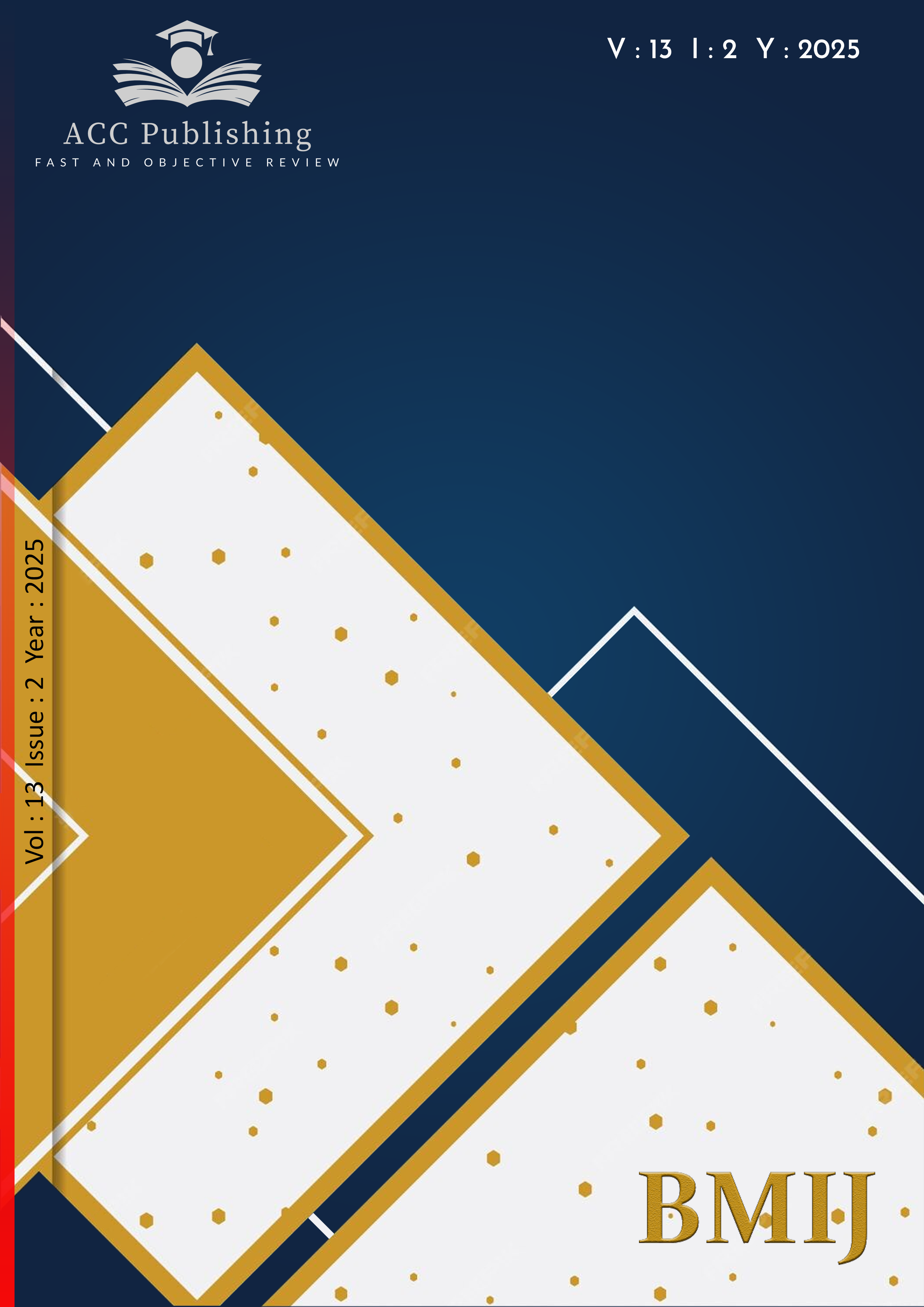Bilinçli farkındalığın işe bağlı duygusal tükenmişlik üzerindeki etkisinde psikolojik sağlamlığın ve iş yükü algısının aracı rolü

Yayınlanmış 25.06.2025
Anahtar Kelimeler
- Bilinçli Farkındalık, Duygusal Tükenmişlik, Psikolojik Sağlamlık, İş Yükü Algısı, Sağlık Çalışanları
- Mindfulness, Emotional Burnout, Psychological Resilience, Workload Perception, Healthcare Professionals
Nasıl Atıf Yapılır
Telif Hakkı (c) 2025 Fatma Zehra Yıldız- Dilek Erdoğan

Bu çalışma Creative Commons Attribution-NonCommercial-NoDerivatives 4.0 International License ile lisanslanmıştır.
Nasıl Atıf Yapılır
Öz
Bu çalışmanın amacı, bilinçli farkındalığın işe bağlı duygusal tükenmişlik üzerindeki etkisini incelemek ve bu etkide psikolojik sağlamlık ile iş yükü algısının aracı rolünü belirlemektir. Araştırmanın evrenini Mersin ve Adana illerinde ikamet eden sağlık çalışanları oluşturmaktadır. Araştırma kapsamında, 214 çalışandan anket yöntemiyle elde edilen veriler Smart PLS programı ile analiz edilmiştir. Çalışmanın sonucunda iş yükü algısının bilinçli farkındalık ile duygusal tükenmişlik arasındaki ilişkide kısmi bir aracılık rolü üstlendiği tespit edilmiştir. Psikolojik sağlamlığın ise bilinçli farkındalık ile duygusal tükenmişlik arasındaki ilişkide istatistiksel olarak anlamlı bir aracı rol üstlenmediği ortaya çıkmıştır. Ayrıca çalışanların bilinçli farkındalığının, psikolojik sağlamlığın ve iş yükü algısının çalışanların duygusal tükenmişliği üzerinde etkisi olduğu sonucuna ulaşılmıştır. Dolayısıyla sağlık kurumlarında çalışanların bilinçli farkındalık ve psikolojik sağlamlık düzeylerini artırmaya yönelik bütüncül politikaların geliştirilmesi önem taşımaktadır. Çalışmanın bulgularının sağlık alanında araştırmacılara ve uygulayıcılara katkı sağlaması umulmaktadır.
Referanslar
- Abenavoli, R., Jennings, P., Greenberg, M., Harris, A., & Katz, D. (2013). The protec-tive effects of mindfulness against burnout among educators. The Psychology of Education Review, 37, 57–69. https://doi.org/10.53841/bpsper.2013.37.2.57
- Ağırkaya, K., & Erdem, R. (2023). Psikolojik sağlamlık: Sağlık çalışanları açısından bir değerlendirme. Pamukkale Üniversitesi İşletme Araştırmaları Dergisi, 10(2), 656-678. https://doi.org/10.47097/piar.1254928
- Arrogante, O. (2014). Mediator effect of resilience between burnout and health in nursing staff. Enfermería Clínica, 24(5), 283–289. https://doi.org/10.1016/j.enfcli.2014.06.003
- Baer, R. A., Smith, G. T., Hopkins, J., Krietemeyer, J., & Toney, L. (2006). Using self-report assessment methods to explore facets of mindfulness. Assessment, 13, 27–45. https://doi.org/10.1177/1073191105283504
- Baron, R. M., & Kenny, D. A. (1986). The moderator–mediator variable distinction in social psychology research: Conceptual, strategic, and statistical considerations. Journal of Personality and Social Psychology, 51, 1173–1182.
- Bayighomog, S. W., Ogunmokun, O. A., Ikhide, J. E., & vd. (2023). How and when mindfulness inhibits emotional exhaustion: A moderated mediation model. Current Psychology, 42, 9080–9094. https://doi.org/10.1007/s12144-021-02193-6
- Bagozzi, R.P. & Yi, Y. (1988). On the evaluation of structural equation models. Jams 16, 74-94. https://doi.org/10.1007/BF02723327.
- Bozkurt, D., & Levent, F. (2021). Öğretmenlerin psikolojik dayanıklılık ile tükenmişlik düzeyleri arasındaki ilişki. OPUS International Journal of Society Researches, 18(44), 7968-8000. https://doi.org/10.26466/opus.937692
- Chheda, K. (2020). Effects of nurses'workload on creativity and innovation: Examining the role of trait mindfulness as a moderator (Master's thesis). University of Central Florida.
- Chandler, D., 2014. Beyond neoliberalism: resilience, the new art of governing complexity. Resilience, 2 (1), 47–63. https://doi.org/10.1080/21693293.2013.878544
- Charoensukmongkol, P., & Suthatorn, P. (2018). Salespeople's trait mindfulness and emotional exhaustion: The mediating roles of optimism, resilience, and self-efficacy. International Journal of Services, Economics and Management, 9(2), 125–142.
- Cleary, M., Kornhaber, R., Thapa, D. K., West, S., & Visentin, D. (2018). The effectiveness of interventions to improve resilience among health professionals: A systematic review. Nurse Education Today, 71, 247–263. https://doi.org/10.1016/j.nedt.2018.10.002
- Cohen, L., Manion, L., & Morrison, K. (2007). Research methods in education. Routledge.
- Deshpande, A., Raut, R., Mittal, A., & Kaul, N. (2024). Mindfulness matters: Unravelling its influence on job demands and emotional exhaustion in remote work. International Journal of Organizational Analysis. https://doi.org/10.1108/IJOA-05-2024-4493
- Doğan, A., & Basım, N. (2021). Mesleki özdeşleşmenin tükenmişlik üzerine etkisi: İş yükü algısı ve psikolojik dayanıklılığın aracılık rolü. Journal of Mehmet Akif Ersoy University Economics and Administrative Sciences Faculty, 8(3), 1531-1556. https://doi.org/10.30798/makuiibf.911304
- Doğan, A. (2020). Mesleki özdeşleşme ile tükenmişlik ilişkisinde iş yükü algısı ve psikolojik dayanıklılığın aracı rolü (Doctoral dissertation, Başkent Üniversitesi, Ankara, Türkiye).
- Doğan, T. (2015). Kısa psikolojik sağlamlık ölçeğinin Türkçe uyarlaması: Geçerlik ve güvenirlik çalışması. The Journal of Happiness & Well-Being, 3(1), 93-102.
- Erer, B. (2021). Covid-19 sürecinde hastane çalışanlarının yaşadığı duygusal tükenme algıladıkları aşırı iş yükü ile açıklanabilir mi? Afyon Kocatepe Üniversitesi Sosyal Bilimler Dergisi, 23(2), 680-693. https://doi.org/10.32709/akusosbil.851104
- Fırat, M., Gökmen, D. B., Kanbay, Y., & Utkan, M. (2022). Burnout and psychological resilience in nurses: A Structural Equality Modeling. Journal of Education and Research in Nursing, 19(4), 396-402. https://doi.org/10.5152/jern.2022.00908
- Fornell, C., & Larcker, D.F. (1981), Evaluating structural equation models with unobservable variables and measurement error, Journal of Marketing Research, 18(1). 39-50.
- Greenglass, E. R., Burke, R. J., & Fiksenbaum, L. (2001). Workload and burnout in nurses. Journal of Community & Applied Social Psychology, 11, 211- 215. https://doi.org/10.1002/casp.614
- Green, A. A., & Kinchen, E. V. (2021). The effects of mindfulness meditation on stress and burnout in nurses. Journal of Holistic Nursing, 39(4), 356–368. https://doi.org/10.1177/08980101211015818
- Gotink, R. A., Chu, P., Busschbach, J. J. V., Benson, H., Fricchione, G. L., & Hunink, M. G. M. (2015). Standardised mindfulness-based interventions in healthcare: An overview of systematic reviews and meta-analyses of RCTs. PLoS ONE, 10(4), https://doi.org/10.1371/journal.pone.0124344
- Gökkaya, D. (2024). İşe bağlı duygusal tükenmişliğin sessiz istifa üzerine etkisinde çalışma yaşam kalitesinin aracılık rolü: Sağlık çalışanlarında bir araştırma. BMİJ, 12 (3), 644-662. https://doi.org/10.15295/bmij.v12i3.2414
- Guillaumie, L., Boiral, O., & Champagne, J. (2017). A mixed-methods systematic review of the effects of mindfulness on nurses. Journal of Advanced Nursing, 73(5), 1017–1034. https://doi.org/10.1111/jan.13176
- Günay, A., (2021). İşe bağlı duygusal tükenmişlik: Bir ölçek uyarlama çalışması. Çukurova Üniversitesi Sosyal Bilimler Enstitüsü Dergisi, 30(1), 142-149. https://doi.org/10.35379/cusosbil.828921
- Gündüz, E. S., & Öztürk, N. K. (2025). Mental workload as a predictor of burnout in intensive care nurses. Nursing in Critical Care, 30(2), https://doi.org/10.1111/nicc.13173
- Hair, J.F., Hult, G.T.M., Ringle, C., & Sarstedt, M. (2013). A Primer on partial least squaresstructural equation modeling (PLS-SEM). Sage Publications.
- Hair Jr, J. F., Sarstedt, M., Ringle, C. M., & Gudergan, S. P. (2017). Advanced Issues in Partial Least Squares Structural Equation Modeling. SAGE Publications. (03 KJEMS-3.1-2020- 06052020083929, P. 18: 355)
- Harker, R., Pidgeon, A. M., Klaassen, F., & King, S. (2016). Exploring resilience and mindfulness as preventative factors for psychological distress, burnout, and secondary traumatic stress among human service professionals. Work, 54(3), 631-637. https://doi.org/10.3233/WOR-162311
- Henseler, J., Ringle, C, M., & Sinkovics, R. (2009). The use of partial least squares path modeling in international marketing. In Sinkovics, R. & Ghauri, P. (Eds.), New challenges to international marketing (p. 277 – 319). Emerald Group Publishing Limited.
- Henseler, J., Ringle, C. M. & Sarstedt, M. (2015). A new criterion for assessing discriminant validity in variance-based structural equation modeling. Journal of the Academy of Marketing Science, 43, 115-135. https://doi.org/10.1007/s11747-014-0403-).
- Hobfoll, S. E. (2011). Conservation of resource caravans and engaged settings. Journal of Occupational and Organizational Psychology, 84, 116–122. https://doi.org/10.1111/j.2044-8325.2010.02016.x
- Hobfoll, S. E. (2001). The influence of culture, community, and the nested-self in the stress process: Advancing conservation of resources theory. Applied Psychology: An International Review, 50(3), 337–421. https://doi.org/10.1111/1464-0597.00062
- Hu, B., Zhu, Y., Liu, C., Zheng, S., Zhao, Z., & Bao, R. (2024). Collectivism, face concern and Chinese-style lurking among university students: The moderating role of trait mindfulness. Frontiers in Psychology, 15, https://doi.org/10.3389/fpsyg.2024.1298357
- Hu, L. T., & Bentler, P. M. (1999). Cutoff criteria for fit indexes in covariance structure analysis. Structural Equation Modeling: A Multidisciplinary Journal.
- Hülsheger, U. R., Walkowiak, A., & Thommes, M. S. (2018). How can mindfulness be promoted? Workload and recovery experiences as antecedents of daily fluctuations in mindfulness. Journal of Occupational and Organizational Psychology, 91(2), 261-284. https://doi.org/10.1111/joop.12206
- Ilies, R., Huth, M., Ryan, A. M., & Dimotakis, N. (2015). Explaining the links between workload, distress, and work–family conflict among school employees: Physical, cognitive, and emotional fatigue. Journal of Educational Psychology, 107(4), 1136–1149. https://doi.org/10.1037/edu0000029
- Jackson, D., Firtko, A., & Edenborough, M. (2007). Personal resilience as a strategy for surviving and thriving in the face of workplace adversity: A literature review. Journal of Advanced Nursing, 60(1), 1–9. https://doi.org/10.1111/j.1365-2648.2007.04412.x
- Li, J. J., Wong, I. A., & Kim, W. G. (2017). Does mindfulness reduce emotional exhaustion? A multilevel analysis of emotional labor among casino employees. International Journal of Hospitality Management, 64, 21-30. https://doi.org/10.1016/j.ijhm.2017.03.008
- Kaya, Ç., & Deniz, A. (2021). Çağrı merkezlerinde iş yükünün işte tükenmişlik duygusu üzerindeki etkisi. Journal of Life Economics, 8(1), 81-92. https://doi.org/10.15637/jlecon.8.1.08
- Kıraç, A. (2024). Sağlık çalışanlarının psikolojik sağlamlıkları, bilinçli farkındalıkları, duygu düzenleme becerileri ve aleksitimi düzeyleri arasındaki ilişkinin belirlenmesi (Yüksek lisans tezi). Aksaray Üniversitesi.
- Kızılkaya, S., & Senel Tekin, P. (2023). İş yükünün psikolojik sağlamlık üzerine etkisinde işe bağlı duygusal tükenmişliğin aracı rolü. Hacettepe University Faculty of Health Sciences Journal, 10(3), 677-694. https://doi.org/10.21020/husbfd.1308071
- Kock, N. (2015). Common method bias in PLS-SEM: A full collinearity assessment approach. International Journal of E-Collaboration, 11(4), 1-10.
- Koca, M., Deniz, S., İnceoğlu, F., & Kılıç, A. (2024). The effects of workload excess on quality of work life in third-level healthcare workers: A structural equation modeling perspective. Healthcare, 12(6), 651. https://doi.org/10.3390/healthcare12060651
- Korkmaz, H. (2023). COVID-19 pandemi sürecinde hemşirelerde tükenmişlik ve psikolojik dayanıklılık arasındaki ilişki (Yüksek lisans tezi) Biruni Üniversitesi.
- Lee, Y. H., Richards, K. A. R., & Washburn, N. (2021). Mindfulness, resilience, emotional exhaustion, and turnover intention in secondary physical education teaching. European Review of Applied Psychology, 71(6), https://doi.org/10.1016/j.erap.2021.100625
- Mansfield, C. F., Beltman, S., Price, A., & McConney, A. (2012). "Don't sweat the small stuff": Understanding teacher resilience at the chalkface. Teaching and Teacher Education, 28(3), 357–367. https://doi.org/10.1016/j.tate.2011.11.001
- Maslach C. (1993) Burnout: a multidimensional perspective. In Professional Burnout: Recent Developments in Theory and Research (W.B. Schaufeli, C. Maslach & T. Marek eds), pp. 19–32, Taylor & Francis, Washington, DC.
- Maslach, C., & Jackson, S.E. (1981). The measurement of experienced burnout. Journal of Occupational Behavior, 2(2), 99-113. https://doi.org/10.1002/job.4030020205
- Maxwell, L., & Duff, E. (2016). Mindfulness: An effective prescription for depression and anxiety. The Journal for Nurse Practitioners, 12(6), 403–409. https://doi.org/10.1016/j.nurpra.2016.02.009
- Mæstad, O., Torsvik, G., & Aakvik, A. (2010). Overworked? On the relationship between workload and health worker performance. Journal of Health Economics, 29(5), 686-698. https://doi.org/10.1016/j.jhealeco.2010.05.006
- Merino-Godoy, M. Á., Yot-Domínguez, C., Conde-Jiménez, J., Ramírez Martín, P., & Lunar-Valle, P. M. (2022). The influence of emotional burnout and resilience on the psychological distress of nursing students during the COVID-19 pandemic. International Journal of Mental Health Nursing, 31(6), 1457-1466. https://doi.org/10.1111/inm.13046
- Montani, F., Vandenberghe, C., Khedhaouria, A., & Courcy, F. (2020). Examining the inverted U-shaped relationship between workload and innovative work behavior: The role of work engagement and mindfulness. Human Relations, 73(1), 59–93. https://doi.org/10.1177/0018726719893380
- Nar, S. D., & Çakmak Tolan, Ö. (2022). Üniversite öğrencilerinde algılanan duygusal istismar ile psikolojik sağlamlık ve bilinçli farkındalık arasındaki ilişkilerin incelenmesi. Uluslararası Anadolu Sosyal Bilimler Dergisi, 6(1), 356-377. https://doi.org/10.47525/ulasbid.1054511
- Norouzi, E., Gerber, M., Masrour, F. F., Vaezmosavi, M., Puehse, U., & Brand, S. (2020). Implementation of a mindfulness-based stress reduction (MBSR) program to reduce stress, anxiety, and depression and to improve psychological well-being among retired Iranian football players. Psychology of Sport and Exercise, 47, https://doi.org/10.1016/j.psychsport.2019.101636
- Mesmer-Magnus, J., Manapragada, A., Viswesvaran, C., & Allen, J. (2017). Trait mindfulness at work: A meta-analysis of the personal and pro-fessional correlated of trait mindfulness. Human Performance, 30, 79–98. https://doi.org/10.1080/08959285.2017.1307842
- Montero-Marin, J., Tops, M., Manzanera, R., Piva Demarzo, M. M., Álvarez de Mon, M., & García-Campayo, J. (2015). Mindfulness, resilience, and burnout subtypes in primary care physicians: The possible mediating role of positive and negative affect. Frontiers in Psychology, 6. https://doi.org/10.3389/fpsyg.2015.01895
- Ringle, PDC (nd), 2024. Fit Measures in SmartPLS. Retrieved February 13, 2024, from https://www.smartpls.com/documentation/algorithms-and- techniques/model-fit/
- Özyeşil, Z., Arslan, C., Kesici, Ş. & Deniz, M. E. (2011). Bilinçli farkındalık ölçeğinin Türkçeye uyarlama çalışması. Eğitim ve Bilim, 36(160), 224-235.
- Podsakoff, P.; MacKenzie, S.; Lee, J. & Posakoff, N. (2003). Common method biases in behavioral research: A critical review of the literature and recommended remedies. Journal of Applied Psychology, 88 (5), 879–903.
- Rafique, M., Jaafar, M., Zafar, A., & Ahmed, S. (2023). Time pressure, emotional exhaustion and project manager abusive supervision in the construction industry: The role of psychological resilience. International Journal of Organization Theory & Behavior, 26(1/2), 132-151. https://doi.org/10.1108/IJOTB-02-2022-0034
- Ramasubramanian, S. (2017). Mindfulness, stress coping and everyday resilience among emerging youth in a university setting: a mixed methods approach. International Journal of Adolescence and Youth, 22(3), 308-321.
- Rees, C. S., Breen, L. J., Cusack, L., & Hegney, D. (2015). Understanding individual resilience in the workplace: The international collaboration of workforce resilience model. Frontiers in Psychology, 6, 73. https://doi.org/10.3389/fpsyg.2015.00073
- Rotenstein, L. S., Brown, R., Sinsky, C., vd. (2023). The association of work overload with burnout and intent to leave the job across the healthcare workforce during COVID-19. Journal of General Internal Medicine, 38(8), 1920–1927. https://doi.org/10.1007/s11606-023-08153-z
- Ryan, R. M., & Deci, E. L. (2000). Self-determination theory and the facilitation of intrinsic motivation, social development, and well-being. American Psychologist, 55, 68–78.
- Sampei, M., Okubo, R., Sado, M., Piedvache, A., Mizoue, T., Yamaguchi, K., & Morisaki, N. (2022). Emotional exhaustion of burnout among medical staff and its association with mindfulness and social support: A single center study during the COVID-19 pandemic in Japan. Frontiers in Psychiatry, 13, https://doi.org/10.3389/fpsyt.2022.774919
- Sarazine, J., Heitschmidt, M., Vondracek, H., Sarris, S., Marcinkowski, N., & Kleinpell, R. (2021). Mindfulness workshops effects on nurses' burnout, stress, and mindfulness skills. Holistic Nursing Practice, 35(1), 10–18. https://doi.org/10.1097/HNP.0000000000000378
- Shapiro, S. L. & Carlson, L. E. (2017). The art and science of mindfulness: Integrating mindfulness into psychology and the helping professions. Washington, DC: American Psychology Press.
- Shapiro, S., Siegel, R. & Neff, K.D. (2018). Paradoxes of mindfulness. Mindfulness, 9, 1693–1701. https://doi.org/10.1007/s12671-018-0957-5
- Spector, P, E., & Jex, S.M. (1998). Development of four self-report measures of job stressors and strain: Interpersonal conflict at work scale, organisational constraints scale, quantitative workload inventory, and physical symptoms inventory. Journal of Occupational Health Psychology, 3(4), 365-367.
- Talebiazar, N. A., Anzali, B. C., & Goli, R. A. (2020). COVID-19 and its mental health effects on nurses and health workers: A narrative review. Pakistan Journal of Medical & Health Sciences, 14, 1453–1456.
- Talebi-Azar, N., Salamat, E., Abbasi, M., Azizi, N., Goli, R., Faraji, N., Bagheri, M., Amiri, N., & Kazemi, S. (2024). The impact of mindfulness-based stress reduction training on the occupational stress and burnout experienced by nurses in geriatric wards: A randomised controlled trial. Geriatric Nursing, 58, 373–381. https://doi.org/10.1016/j.gerinurse.2024.05.034
- Tarsuslu, S., & Bağcı, Y. (2024). Sağlık çalışanlarının psikolojik sağlamlıklarının tükenmişlik düzeyleri üzerindeki etkisi: Örgütsel bağlılığın aracılık rolü. Uluslararası Sağlık Yönetimi ve Stratejileri Araştırma Dergisi, 10(3), 173-188.
- Tonga, F. E., & Tantekin Erden, F. (2021). Okul öncesi öğretmenlerinin bilinçli farkındalık ve tükenmişlik puanları arasındaki ilişkinin incelenmesi. Mehmet Akif Ersoy Üniversitesi Eğitim Fakültesi Dergisi, 60, 151-174.
- Tugade, M.M. & Fredrickson, B.L. (2007), Regulation of positive emotions: emotion regulation strategies that promote resilience, Journal of Happiness Studies, 8(3), 311-333. https://doi.org/10.1007/s10902-006-9015-4
- Turunç, Ö., & Öğen, A. R. (2022). Aşırı iş yükü tükenmişlik ilişkisinde, iş tatmini ve örgütsel vatandaşlık rolü: Sağlık çalışanlarında bir uygulama. Türk Sosyal Bilimler Araştırmaları Dergisi, 7(2), 118-128.
- Werneburg, B. L., Jenkins, S. M., Friend, J. L., Berkland, B. E., Clark, M. M., Rosedahl, J. K., ... Sood, A. (2018). Improving resiliency in healthcare employees. American Journal of Health Behavior, 42(1), 39-50. https://doi.org/10.5993/AJHB.42.1.4
- Wood, A. E., Prins, A., Bush, N. E., Hsia, J. F., Bourn, L. E., Earley, M. D., ... Ruzek, J. (2017). Reduction of burnout in mental health care providers using the provider resilience mobile application. Community Mental Health Journal, 53(4), 452–459. https://doi.org/10.1007/s10597-016-0076-5
- Wong, K. K. K. (2013). Partial least squares structural equation modeling (PLS-SEM) techniques using smartpls. Marketing Bulletin, 24(1), 1-32.
- Verplanken, B., & Fisher, N. (2014). Habitual worrying and benefits of mindfulness. Mindfulness, 5(5), 566–573. https://doi.org/10.1007/s12671-013-0211-0
- Verweij, H., van Ravesteijn, H., van Hooff, M. L. M., vd., (2018). Mindfulness-based stress reduction for residents: A randomised controlled trial. Journal of General Internal Medicine, 33, 429–436. https://doi.org/10.1007/s11606-017-4249-x
- Vinzi, V. E., Chin, W. W., Henseler, J., & Wang, H. (2009). Perspectives on partial least squares. In Handbook of partial least squares: Concepts, methods and applications (pp. 1-20). Berlin, Heidelberg: Springer Berlin Heidelberg.
- Yıldırım, Y., Taşmektepligil, M. Y. & Üzüm, H. (2011). Kısa versiyon örgütsel stres ölçeğinin Türkçeye uyarlanması. Selçuk Üniversitesi Beden Eğitimi ve Spor Bilim Dergisi, 13(1), 103-108.
- Zhou, T. (2013). Understanding continuance usage of mobile sites. Industrial Management & Data Systems, 113(9), 1286–1299.



